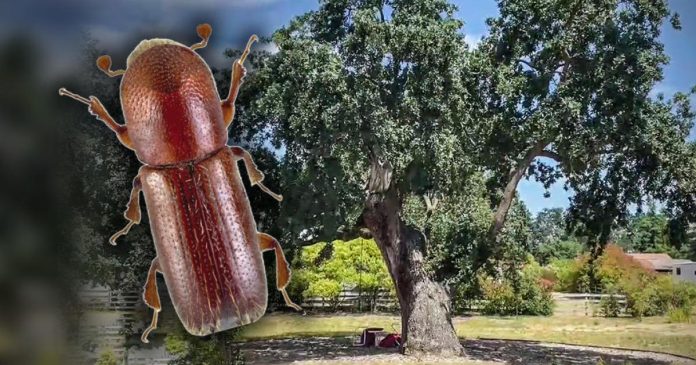SANTA ROSA — An invasive pest has been found in oak trees in a western Santa Rosa neighborhood, alarming officials and tree experts. As the number of dying infected trees increases, removing those trees could make the problem worse.
The majestic live oaks that line the highway in rural Sonoma County give the area a timeless feel, but in Zack Fresco’s backyard, a 175-year-old tree is a giant pile of wood under a plastic tarp.
“It breaks my heart,” Fresco said. “One of my neighbor’s trees fell down in a storm, and my children and I went and ground down the trunk so we could count the rings and came up with 360 years. Think about what happened back then. They come from another time.”
It wasn’t a storm that killed Fresco’s tree. It was an invasive beetle called the Mediterranean oak borer. Common to many European countries, including France, the beetle was first discovered in California in the Calistoga area about six years ago. The drillers are suspected to have hitchhiked into Northern California with imported wood used to make wine barrels.
“You can’t fly abroad. They must have been brought to California or this area by some contaminated plant material,” said Dr. Akif Eskalen, UC Davis plant pathologist.
Now says Dr. Escalates that the beetles are taking advantage of the weakness of many trees after three years of extreme drought.
“If we didn’t have this bug, would this drought cause a hundred-year-old tree to be killed? Possibly not,” said Dr. escalations “They cause stress to the plants, but don’t kill them. But these guys – the secondary plants – when they come, they kill them.”
It may seem that the solution is to remove the infected trees, but Merlin Schlumberger, the master arborist who identified the borers in Fresco’s tree, said preventing the pest from spreading further presents a difficult dilemma for tree fellers .
“Normally the arborist would remove it, take away the wood, take away the wood chips. ‘Bugs are coming out and we’re starting to see that. New sites are emerging with new dead trees here and there,” Schlumberger explained.
The felled tree remains under a plastic cover for the time being. The hope is that the sun’s heat will kill the trapped pests after a few months. It’s still just an experiment, and Fresco set a trap nearby to monitor for any drills escaping. Meanwhile, Schlumberger wonders what this could mean for the future of the area’s picturesque oak trees.
“If it continues to spread, which it likely will, that’s not good news,” he said. “I don’t think something like this will lead to extinction, but for those of us who care about valley corpses, it’s probably the most concerning thing I’ve ever encountered.”
Now that the drills have reached the residential areas of western Santa Rosa, there are concerns that they may spread much more easily. They can fly, but they don’t usually travel very far, and the idea of solarizing every dead tree with plastic seems impractical. Schlumberger therefore calls for quick action. He believes the county should designate a site away from uninfected oak trees to establish a quarantine zone so fellers can dispose of infested wood.
John Ramos
www.cbsnews.com
https://www.cbsnews.com/sanfrancisco/news/eliminating-infected-north-bay-oak-trees-may-further-spread-pests/














